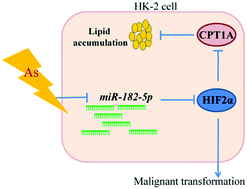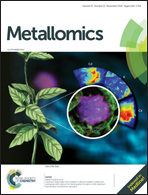miRNA-182-5p, via HIF2α, contributes to arsenic carcinogenesis: evidence from human renal epithelial cells†
Abstract
Chronic exposure to high levels of arsenic has been associated with high risks for many cancers, including renal cell carcinoma (RCC). However the underlying mechanisms are not clear. In the present study, chronic arsenite exposure (2 μM or 5 μM, 30 weeks) induced malignant transformation of HK-2 human renal epithelial cells as indicated by elevated colony formation (6.2- and 5.4-fold increase, respectively), secreted MMP-9 activity (10.1- and 11.3-fold increase, respectively) and proliferation rate (1.2- and 1.3-fold increase in 72 h, respectively). Lipid accumulation, typical of clear cell RCC, was observed in arsenic-transformed (As-TM) cells. Overexpression of hypoxia-inducible factor 2α (HIF2α) and suppression of carnitine palmitoyltransferase 1A (CPT1A) were found at the level of mRNA (1.5- and 0.49-fold of control, respectively) and protein (4.0- and 0.28-fold of control, respectively) after exposure to 2 μM arsenite for 20 weeks. Silencing of HIF2α significantly attenuated arsenite-induced malignant phenotypes and lipid accumulation. Inactivation of Von Hippel-Lindau (VHL) and impaired protein degradation of HIF2α were not found in As-TM cells. Expression of miR-182-5p and miR-802 in As-TM cells was 42.4% and 54.0% of control, respectively (p < 0.05). The levels of mRNA and protein of HIF2α were increased 2.4 folds and 1.6 folds of negative control in response to the miR-182-5p inhibitor, respectively, but decreased to 58.1% and 50.1% of negative control in response to miR-182-5p mimics, respectively. No significant alteration was observed in HIF2α expression when miR-802 was silenced. Our data provide further evidence for the carcinogenic role of arsenic in the kidney. Moreover, the miR-182-5p/HIF2α pathway is indicated to be involved in malignant transformation of human renal epithelial cells under arsenite exposure.

- This article is part of the themed collection: Metallomics Recent HOT articles


 Please wait while we load your content...
Please wait while we load your content...